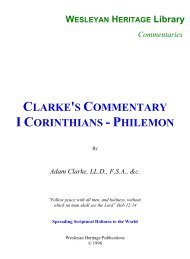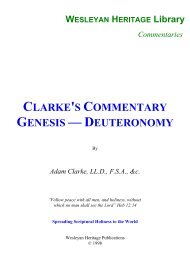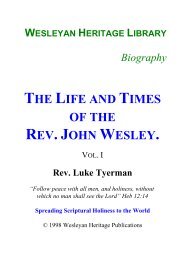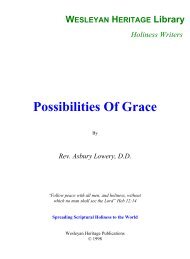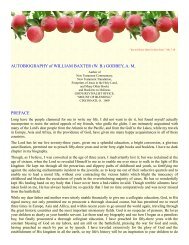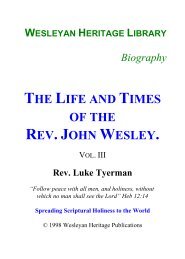2. The Meaning of Sanctification - Enter His Rest
2. The Meaning of Sanctification - Enter His Rest
2. The Meaning of Sanctification - Enter His Rest
Create successful ePaper yourself
Turn your PDF publications into a flip-book with our unique Google optimized e-Paper software.
know as "the moral image <strong>of</strong> God", an instinct which has never been put together again in<br />
human nature, except by a miracle <strong>of</strong> the grace <strong>of</strong> God. One thing to remember in this<br />
figure <strong>of</strong> Bergson’s is that being philosophical, it is non-theological; consequently,<br />
Bergson omitted the place <strong>of</strong> God in man’s original sound moral instinct, but we do not<br />
need to omit that, and when we place that firmly in position we can see what possession<br />
<strong>of</strong> the moral image <strong>of</strong> God in Adam must have meant. It meant that Adam would<br />
instinctively do by preference and inward bent <strong>of</strong> desire those things which would<br />
contribute to the welfare <strong>of</strong> the whole human race whenever it came into existence and<br />
would express the love and devotion <strong>of</strong> his heart to God as Father and personal Friend.<br />
CAN INSTINCT BE SINFUL?<br />
Dr. Sangster has challenged the common doctrine that the instincts <strong>of</strong> a sinful man may<br />
be sinful instincts. He identifies the sinful instincts <strong>of</strong> humanity with the normal urges <strong>of</strong><br />
human life, such as the hunger for food, sexual desire, self-respect, and the like. <strong>The</strong>se, he<br />
thinks cannot be sinful in themselves. It is only when they are consciously yielded to sin<br />
that they may be said to be <strong>of</strong> the nature <strong>of</strong> sin.<br />
In reply, it can be said that these impulses <strong>of</strong> human nature, which make life possible both<br />
in its beginning and in its continuance, were not essentially sinful in themselves at the<br />
beginning. This can be conceded, because we believe that Adam possessed these natural<br />
urges at the beginning <strong>of</strong> his existence. What we hold is that these urges have been<br />
infected and poisoned by the nature <strong>of</strong> sin, just as if a man should get arthritis in his hand,<br />
which would cause his hand to swell and be painful and deformed. Such a man would not<br />
want his hand cut <strong>of</strong>f, but, in popular language, he would want “something taken out” <strong>of</strong><br />
it, namely, the fever and the disease. That figure fairly well describes the infection <strong>of</strong> sin<br />
in the impulses <strong>of</strong> human nature.<br />
Furthermore, there is a strange quality about instinct to which previous allusion has been<br />
made, namely, it combines many natural impulses into a distinct pattern <strong>of</strong> behavior that<br />
produces a result entirely unforeseen and not consciously planned. <strong>The</strong> original nature <strong>of</strong><br />
man, as Bergson has suggested, was endowed with an instinct like that, -directed toward<br />
moral and religious living.<br />
Adam’s fall involved a breaking up <strong>of</strong> that instinctive pattern <strong>of</strong> moral and religious<br />
behavior. <strong>The</strong> lack <strong>of</strong> that instinctive pattern, together with the infection <strong>of</strong> man’s<br />
impulses by self-regarding desires, lays the citadel <strong>of</strong> man’s soul open to sin through<br />
every avenue <strong>of</strong> his being. Broken fragments <strong>of</strong> the original instincts remain in the most<br />
evil and depraved heart which, when touched by the Spirit <strong>of</strong> God, awaken a hope <strong>of</strong><br />
holiness and salvation in the most wicked soul. But the tendency toward sin does not need<br />
any organized pattern; for in its essential nature sin is anarchy.<br />
Holiness, however, represents a definite pattern <strong>of</strong> life that cannot successfully be<br />
followed in constant warfare against an inward tendency to sin. Moreover, consistent<br />
pursuit <strong>of</strong> the good life requires something like an instinctive organization <strong>of</strong> all man’s<br />
powers to follow the ideal <strong>of</strong> holiness, not merely by will power, but by inward desire.<br />
FIGURES OF DEPRAVITY<br />
From the beginning <strong>of</strong> man’s thought about the eternal, he has been baffled by all efforts<br />
to describe the invisible things <strong>of</strong> the spirit in the language <strong>of</strong> his earthly life. It has<br />
always been necessary to use figures <strong>of</strong> speech to say that this is like that. Despisers <strong>of</strong><br />
religion have mocked this use <strong>of</strong> figurative language in all religious literature. In doing so<br />
they have sc<strong>of</strong>fed at all the terminology <strong>of</strong> man’s intelligent life, which lifts him above<br />
the beast; for not only the language <strong>of</strong> religion, but also the language <strong>of</strong> the intellect, is<br />
based upon figures <strong>of</strong> speech. Pr<strong>of</strong>. W. S. Jevons, in his book on logic, has described this



